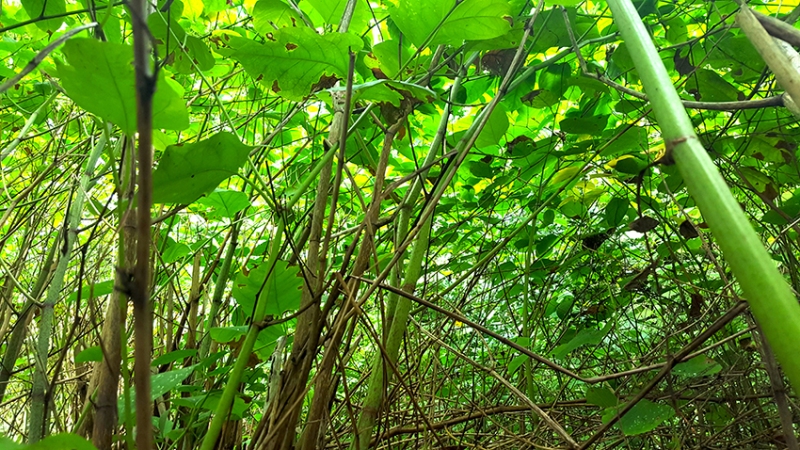The perils of ignoring Japanese knotweed for commercial businesses
In this article we explain the pitfalls and perils of doing just that, and the help that is available should you fall into the jaws of the law.
Let’s start with legislation. It is well documented that Japanese knotweed is listed in The Wildlife and Countryside Act 1981, but what does that mean exactly? This Act exists to ensure responsibility is taken by the producers of waste (such as Japanese knotweed) for managing their waste and avoiding harm to human health or the environment. It is an offence under Section 14(2) of the Act to “plant or otherwise cause to grow in the wild” any plants listed in Schedule 9, Part II.
Whilst it is not illegal to have Japanese knotweed on your land or property, clearly there are legal consequences associated with failing to control it. Control measures usually mean either having a knotweed management programme in place that will force the plant into a dormant state over time, or by excavating all parts of the plant and disposing of it according to government regulations. You may also be at risk of prosecution if found guilty of disposing of Japanese knotweed in the wild as knotweed is deemed as controlled noxious waste and therefore has legalities around its disposal.
Government guidelines state:
“You must dispose of Japanese knotweed waste off-site by transferring it to a disposal facility that’s permitted, e.g. a landfill site that has the right environmental permit.”
“You must prevent Japanese knotweed on your land from spreading into the wild and causing a nuisance. You could be fined up to £5,000 or be sent to prison for up to 2 years if you allow contaminated soil or plant material from any waste you transfer to spread into the wild.”
Habitat
Knotweed is extremely resilient, it thrives on commercial property, waste land deemed for development, alongside railway tracks, and will invade pretty much any open space when allowed to do so. It is often found on commercial sites due to encroachment from adjacent land where it has been allowed to flourish. Knotweed grows prolifically via a network of hidden underground rhizomes (roots) that can spread underneath boundaries such as fencing or walls, making it difficult to contain, and difficult to eradicate.
Enroachment
If Japanese knotweed is allowed to spread beyond a property’s boundary it is deemed as “encroachment”, and this applies even if just the underground rhizome (root) of the plant is found to have spread from one property to another. So, if a property or landowner has knotweed present, they should make every effort to control all parts of the knotweed plant to avoid spread.
Consequences
If Japanese knotweed is not controlled or removed and it spreads from one property to another the relevant law is that of “private nuisance”, which is defined as “an act or omission which is an interference with, disturbance of or annoyance to a person in the exercise or enjoyment of his ownership or occupation of land”.
Actionable private nuisance claims can be served against persons found responsible for having allowed or caused Japanese knotweed encroachment to take place and can cost multiple thousands of pounds.
Actions
Even if one small knotweed fragment is found onsite the area must be closed off, signage put in place and the experts brought in. The consequences are not good – for construction this will mean project on hold, loss of productive activity, site workers put on leave until further notice, loss of contractors, and the project timeline disturbed. For all commercial businesses there will undoubtedly be a financial impact.
Advice
As commercial solicitors, we consult with experts such as Japanese Knotweed Ltd to keep up to date with current industry updates and control measures.
Here is our best advice for limiting the damage that knotweed can do to your business:
- Have a professional pre-purchase survey carried out. This will determine whether above ground plants are knotweed or a harmless lookalike, or whether knotweed is lurking below ground, and remedial work can sometimes be factored into the purchase price and project management plan.
- If you have purchased property or land, paid for a survey by a company not specialised in invasive weed management, and the surveyor failed to pick up the presence of knotweed, you may be able to bring a claim against the surveyor for professional negligence. If you can show that the surveyor should have noticed the knotweed, you can make a claim.
- When developing a site affected by Japanese knotweed, if the necessary due diligence and control of Japanese knotweed has not been undertaken, the developers risk legal action for professional negligence. Ignoring knotweed can result in regrowth during or after construction, appearing through hard and soft landscape areas on the purchaser’s property which will require treatment or removal.
We can help
We can put you in touch with our recommended contractor to arrange a professional survey, treatment plan or full eradication. We can help you with submitting a claim for professional negligence or if you need advice on any legal action taken against you.

LEEDS
One Park Row
Leeds,
West Yorkshire
LS1 5AB
Phone: +44 (0) 113 856 0446
Email: hello@hagenwolf.co.uk
Web: www.hagenwolf.co.uk
LONDON*
One Pancras Square
King's Cross
London
N1C 4AG
Phone: +44 (0) 207 846 4146
Email: hello@hagenwolf.co.uk
Web: www.hagenwolf.co.uk
NEWCASTLE*
Bank House
Pilgrim Street
Newcastle
NE1 6QF
Phone: +44 (0) 113 856 0446
Email: hello@hagenwolf.co.uk
Web: www.hagenwolf.co.uk
*‘We do not take service at our London and Newcastle offices. All meetings, at all of our offices, are by appointment only.
Hägen Wolf Limited (trading as Hägen Wolf) are solicitors of England and Wales authorised and regulated by the Solicitors Regulation Authority SRA Number 659328. Details of the Solicitors Code of Conduct can be found at www.sra.org.uk Hägen Wolf Limited is registered at Companies House No. 10830060. Registered Office: One Park Row, Leeds, LS1 5AB. We use the word 'partner' to refer to a shareowner or director of the company, or an employee or consultant who is a lawyer with equivalent standing and qualifications.
Site by: elate global
Contact us
Give us a call on 0330 320 1440 or send us an email at hello@hagenwolf.co.uk or fill in the boxes below and pop over a quick message and a member of the team will get back to you as soon as they're free.




